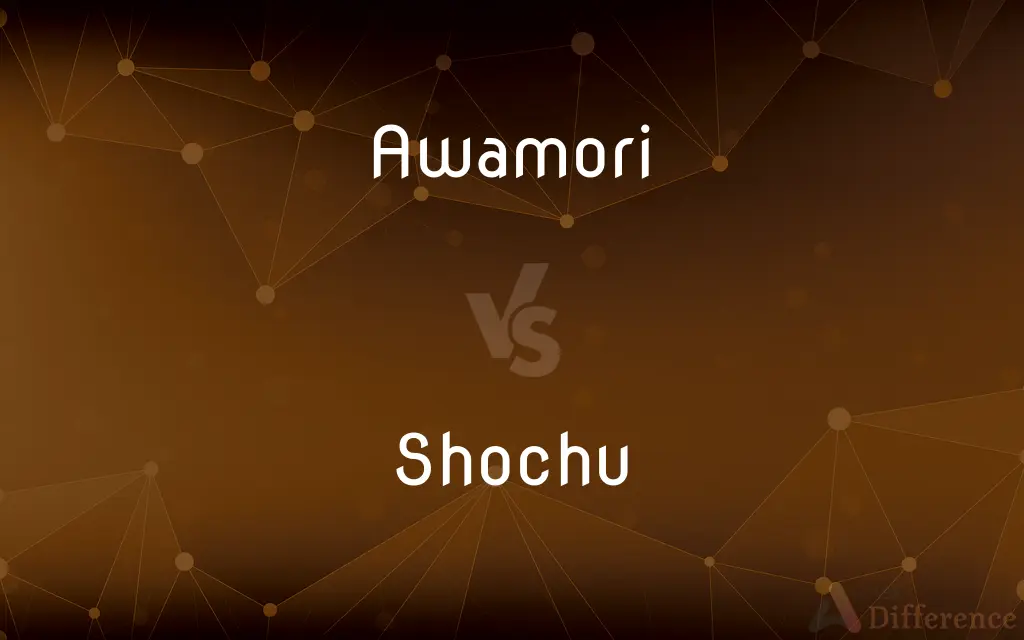Awamori vs. Shochu — What's the Difference?
By Fiza Rafique & Urooj Arif — Updated on May 4, 2024
Awamori is an Okinawan distilled spirit made from long-grain indica rice; shochu, on the other hand, can be made from various ingredients including barley, sweet potatoes, and short-grain rice.

Difference Between Awamori and Shochu
Table of Contents
ADVERTISEMENT
Key Differences
Awamori is a traditional alcoholic beverage from Okinawa, Japan, distinctively made from long-grain Thai rice, and it undergoes a single distillation process. Whereas shochu, which originates from different regions in Japan, utilizes a variety of base ingredients such as barley, sweet potatoes, and rice, and can be distilled multiple times.
Awamori is known for its unique production involving black koji mold which imparts a characteristic flavor and aroma. On the other hand, shochu makers may use white, black, or yellow koji, each contributing differently to the flavor profile.
Awamori is aged in traditional clay pots, enhancing its depth and complexity over time. Conversely, shochu is often enjoyed both fresh and aged, with aging not as prevalent or traditional.
Awamori typically has a higher alcohol content, usually around 30-43%, providing a robust flavor profile. Shochu, however, generally ranges from 25% to 45%, making some varieties milder in comparison.
Both spirits serve as cultural symbols in their respective regions, but awamori is especially revered in Okinawa as a part of local identity and heritage, whereas shochu is celebrated more broadly across Japan for its versatility and variety.
ADVERTISEMENT
Comparison Chart
Base Ingredient
Long-grain indica rice
Varied (barley, sweet potatoes, rice)
Distillation
Single distillation
Can be single or multiple distillations
Koji Type
Black koji mold
White, black, or yellow koji
Traditional Aging
Aged in clay pots
Fresh or aged, less emphasis on aging
Alcohol Content
Typically 30-43%
Ranges from 25% to 45%
Compare with Definitions
Awamori
Usually enjoyed aged, stored in clay pots.
Aged awamori can be sipped slowly to enjoy its enhanced flavors.
Shochu
A Japanese distilled beverage that can be made from various ingredients.
Shochu made from barley has a distinctively different taste from that made from sweet potatoes.
Awamori
A distilled spirit from Okinawa, traditionally made from long-grain Thai rice.
Awamori is celebrated during traditional Okinawan festivals.
Shochu
Can utilize different types of koji mold in production.
The type of koji used significantly affects the flavor of shochu.
Awamori
Integral to Okinawan culture and ceremonies.
Awamori is often presented as a gift during important Okinawan ceremonies.
Shochu
Popular across Japan and varies widely in flavor.
The versatility of shochu makes it a popular choice for a wide range of drinkers.
Awamori
Typically has a higher alcohol content than other Japanese spirits.
Awamori's strong character is due to its higher alcohol percentage.
Shochu
Enjoyed both fresh and aged, flexible in serving methods.
Shochu can be enjoyed on the rocks or mixed in cocktails.
Awamori
Known for its use of black koji mold during fermentation.
The black koji mold gives awamori its unique taste.
Shochu
Produced through either single or multiple distillation processes.
Multiple distillations make some shochu varieties smoother.
Awamori
Awamori (泡盛, Okinawan: アームイ, 'āmui) is an alcoholic beverage indigenous and unique to Okinawa, Japan. It is made from long grain indica rice, and is not a direct product of brewing (like sake) but of distillation (like shōchū).
Shochu
A Japanese alcoholic beverage, most commonly distilled from barley, sweet potato or rice. Typically it is 25% alcohol by volume, making it weaker than whisky, but stronger than wine and sake.
Awamori
A Japanese alcoholic beverage made from rice via distillation.
Common Curiosities
How is awamori distilled?
Awamori undergoes a single distillation process.
What type of koji mold is used in awamori?
Awamori uses black koji mold.
What is awamori made from?
Awamori is made from long-grain indica rice.
What are the different koji molds used in shochu?
Shochu can use white, black, or yellow koji mold.
Is aging important for shochu?
Aging is less emphasized in shochu, although it can be aged.
How is awamori integrated into Okinawan culture?
Awamori is deeply integrated and revered in Okinawan ceremonies and celebrations.
What are common ways to enjoy shochu?
Shochu can be enjoyed neat, on the rocks, or mixed in cocktails.
How is awamori traditionally aged?
Awamori is traditionally aged in clay pots.
What makes shochu popular across Japan?
Shochu is popular due to its versatility in ingredients and methods of consumption.
What ingredients can be used to make shochu?
Shochu can be made from barley, sweet potatoes, rice, and other ingredients.
Can shochu be distilled more than once?
Yes, shochu can undergo multiple distillations.
What is the alcohol range for shochu?
Shochu's alcohol content typically ranges from 25% to 45%.
What is the typical alcohol content of awamori?
Awamori typically has an alcohol content of 30-43%.
Does the taste of awamori change with aging?
Yes, aging typically enhances the depth and complexity of awamori's flavor.
Can awamori be consumed fresh?
Awamori is typically aged, but it can also be consumed fresh.
Share Your Discovery

Previous Comparison
Continue vs. Proceed
Next Comparison
DNA vs. ChromosomeAuthor Spotlight
Written by
Fiza RafiqueFiza Rafique is a skilled content writer at AskDifference.com, where she meticulously refines and enhances written pieces. Drawing from her vast editorial expertise, Fiza ensures clarity, accuracy, and precision in every article. Passionate about language, she continually seeks to elevate the quality of content for readers worldwide.
Co-written by
Urooj ArifUrooj is a skilled content writer at Ask Difference, known for her exceptional ability to simplify complex topics into engaging and informative content. With a passion for research and a flair for clear, concise writing, she consistently delivers articles that resonate with our diverse audience.













































